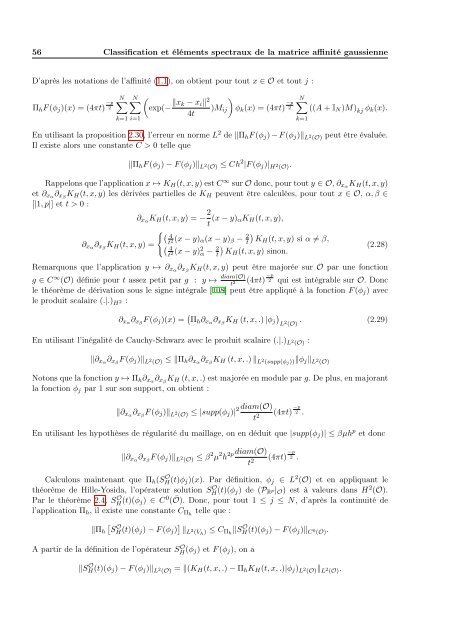Contributions à l'étude de la classification spectrale et applications
Contributions à l'étude de la classification spectrale et applications
Contributions à l'étude de la classification spectrale et applications
Create successful ePaper yourself
Turn your PDF publications into a flip-book with our unique Google optimized e-Paper software.
56 C<strong>la</strong>ssification <strong>et</strong> éléments spectraux <strong>de</strong> <strong>la</strong> matrice affinité gaussienne<br />
D’après les notations <strong>de</strong> l’affinité (1.1), on obtient pour tout x ∈ O <strong>et</strong> tout j :<br />
ΠhF (φj)(x) = (4πt) −p<br />
2<br />
N<br />
k=1 i=1<br />
N<br />
<br />
exp(− xk − xi2 <br />
)Mij φk(x) = (4πt)<br />
4t<br />
−p<br />
2<br />
N<br />
((A + IN)M) kj φk(x).<br />
En utilisant <strong>la</strong> proposition 2.30, l’erreur en norme L 2 <strong>de</strong> ΠhF (φj) − F (φj) L 2 (O) peut être évaluée.<br />
Il existe alors une constante C > 0 telle que<br />
ΠhF (φj) − F (φj) L 2 (O) ≤ Ch 2 |F (φj)| H 2 (O).<br />
Rappelons que l’application x ↦→ KH(t, x, y) est C∞ sur O donc, pour tout y ∈ O, ∂xαKH(t, x, y)<br />
<strong>et</strong> ∂xα∂xβ KH(t, x, y) les dérivées partielles <strong>de</strong> KH peuvent être calculées, pour tout x ∈ O, α, β ∈<br />
[|1, p|] <strong>et</strong> t > 0 :<br />
∂xαKH(t, x, y) = − 2<br />
t (x − y)αKH(t, x, y),<br />
∂xα∂xβ KH(t,<br />
<br />
4<br />
x, y) = t2 (x − y)α(x − y)β − 2<br />
<br />
t KH(t, x, y) si α = β,<br />
<br />
4<br />
t2 (x − y) 2 α − 2<br />
(2.28)<br />
t KH(t, x, y) sinon.<br />
Remarquons que l’application y ↦→ ∂xα∂xβ KH(t, x, y) peut être majorée sur O par une fonction<br />
g ∈ C∞ (O) définie pour t assez p<strong>et</strong>it par g : y ↦→ diam(O)<br />
t2 (4πt) −p<br />
2 qui est intégrable sur O. Donc<br />
le théorème <strong>de</strong> dérivation sous le signe intégrale [108] peut être appliqué <strong>à</strong> <strong>la</strong> fonction F (φj) avec<br />
le produit sca<strong>la</strong>ire (.|.) H 2 :<br />
∂xα∂xβ F (φj)(x) = Πh∂xα∂xβ KH<br />
<br />
(t, x, .) |φj L2 . (2.29)<br />
(O)<br />
En utilisant l’inégalité <strong>de</strong> Cauchy-Schwarz avec le produit sca<strong>la</strong>ire (.|.) L 2 (O) :<br />
∂xα∂xβ F (φj) L 2 (O) ≤ Πh∂xα∂xβ KH (t, x, .) L 2 (supp(φj))φj L 2 (O)<br />
Notons que <strong>la</strong> fonction y ↦→ Πh∂xα∂xβ KH (t, x, .) est majorée en module par g. De plus, en majorant<br />
<strong>la</strong> fonction φj par 1 sur son support, on obtient :<br />
∂xα∂xβ F (φj)<br />
2 diam(O)<br />
L2 (O) ≤ |supp(φj)|<br />
t2 k=1<br />
(4πt) −p<br />
2 .<br />
En utilisant les hypothèses <strong>de</strong> régu<strong>la</strong>rité du mail<strong>la</strong>ge, on en déduit que |supp(φj)| ≤ βµh p <strong>et</strong> donc<br />
∂xα∂xβ F (φj)L2 (O) ≤ β 2 µ 2 2p diam(O)<br />
h<br />
t2 (4πt) −p<br />
2 .<br />
Calculons maintenant que Πh(S O H(t)φj)(x). Par définition, φj ∈ L 2 (O) <strong>et</strong> en appliquant le<br />
théorème <strong>de</strong> Hille-Yosida, l’opérateur solution SO H (t)(φj) <strong>de</strong> (PRp|O) est <strong>à</strong> valeurs dans H2 (O).<br />
Par le théorème 2.4, SO H (t)(φj) ∈ C0 ( Ō). Donc, pour tout 1 ≤ j ≤ N, d’après <strong>la</strong> continuité <strong>de</strong><br />
l’application Πh, il existe une constante CΠh telle que :<br />
O<br />
Πh SH(t)(φj) − F (φj) L2 (Vh) ≤ CΠhSO H(t)(φj) − F (φj)C0 (O).<br />
A partir <strong>de</strong> <strong>la</strong> définition <strong>de</strong> l’opérateur S O H (φj) <strong>et</strong> F (φj), on a<br />
S O H(t)(φj) − F (φj) L 2 (O) = (KH(t, x, .) − ΠhKH(t, x, .)|φj) L 2 (O) L 2 (O).

















